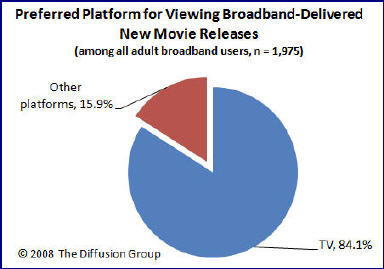-
Fueling Over-the-Top Broadband Video
Today I'm very pleased to introduce Michael Greeson as a contributor to VideoNuze. Michael is the founding partner and Principal Analyst at The Diffusion Group, a leading analytics and advisory firm helping
 companies in the connected home and broadband media markets. VideoNuze has partnered with TDG to bring key highlights of its research and opinions to VideoNuze readers on a regular basis. I'm confident that you'll find them valuable and, as always, look forward to your feedback.A Simple Way to Fuel Diffusion of Over-the-Top Broadband Videoby Michael Greeson
companies in the connected home and broadband media markets. VideoNuze has partnered with TDG to bring key highlights of its research and opinions to VideoNuze readers on a regular basis. I'm confident that you'll find them valuable and, as always, look forward to your feedback.A Simple Way to Fuel Diffusion of Over-the-Top Broadband Videoby Michael GreesonWith the web becoming more about media and entertainment, the rationale to get a broadband conduit into the living room is irrefutable - after all, that's where most consumers have their high-definition TV and their best sound system, it's the home's most comfortable media setting and remains the preferred platform for watching video. Not that a laptop PC in the den, a second TV and stereo in the master bedroom, or even an iPhone are not interesting as video consumption points; of course they are, but not as the primary or preferred setting. As noted below, when asked to choose between TVs, desktop PCs, notebook PCs, or mobile video platforms, close to nine in ten consumers prefer to watch movies on their living room TV.
 Then why are those companies which are pushing a "three screen" video consumption strategy spending most of their energy and resources on the two "new" spaces (that is, PC-based or portable/mobile video consumption) and forgetting about the living room TV altogether? It seems as if open broadband to the TV is not sexy or cool enough for Silicon Valley; too mundane for such "cutting edge" companies.
Then why are those companies which are pushing a "three screen" video consumption strategy spending most of their energy and resources on the two "new" spaces (that is, PC-based or portable/mobile video consumption) and forgetting about the living room TV altogether? It seems as if open broadband to the TV is not sexy or cool enough for Silicon Valley; too mundane for such "cutting edge" companies.I've got news for them: watching video on the TV is not going away anytime soon, meaning that emerging new video models (the other two screens) will serve as supplements to the living room TV, not as replacements. Those pointing to TV's demise (a dubitable and specious position to hold) must know that, even if this happens, it will come about very, very slowly. The TV has proven an incredibly resilient and flexible viewing platform, one whose primacy will be reinforced by new media, not compromised.
For these reasons, I advocate a very simple strategy to help push broadband connectivity into the living room and broadband video into its rightful place. Forget about earmarking Internet connectivity as a "premium" feature reserved only for high-end CE, game consoles, or novel "new media" platforms like Apple TV. Think beyond adding Internet connectivity to a TV (which has a replacement cycle of six to eight years) or a high-def DVD player (a higher-end platform seen as unnecessary to most consumers).
Instead, add Internet connectivity to mainstream consumer electronic devices that are widely diffused, dependable, and which enjoy a more rapid replacement cycle - devices such as low-to-mid-range DVD players. Yes, it would increase the cost of the DVD player, but only slightly, and if there is legitimate value in delivering web-based media to the living room, the cost increase will be seen as tolerable. In the end, there is no better way to accomplish widespread, rapid diffusion than to tie a compelling new application to a trusted (existing) platform that's several hundred dollars cheaper than similarly-enabled platforms.
The argument I've presented above is relatively commonsensical: it is inherently easier to enhance incrementally the features and capabilities of a stable, widely diffused, well-loved platform (like a DVD player) than to try to sell consumers a completely new "black box" that enables a specific set of benefits that, while convincing, may not by themselves be sufficiently compelling to generate a purchase. Moreover, "new media" can benefit immensely by serving "traditional environments." While it is interesting to envision a future where anytime/anywhere video consumption is possible, at this point simply enhancing the primary video experience may be the most practical for "three screen" broadband video players. While not as "hot" or "cool," it will likely prove the most lucrative.
Categories: Aggregators, Devices
Topics: The Diffusion Group

